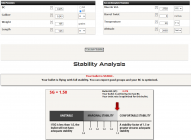The Berger and other widely used stability calculators use the Miller Stability Rules model. It's a much simplified set of calculations that replaces the multiple complex processes ballisticians and the military go through to calculate Sg values to really fine levels, and is therefore simple enough to fit into a simple Excel spreadsheet. It's more than good enough for most recreational shooters though (and much better than the old rule of thumb guidelines that said you can shoot bullets up to such and such a weight in this calibre/twist-rate combination and were often plain wrong).
Back in Miller's day, 1.4 was the 'standard' Sg value for achieving full stability, and as with today's version used 'standard meteorological conditions', ie 29.92-inches Hg atmospheric pressure and 59-deg F air temperature, as the norm with the result affected by differences to these parameters. The spreadsheet results would have the line printed below the result saying something like: 'Stability should be 1.4 or higher. If above 2.0 accuracy may be adversely affected.'
However, more recent work by Bryan Litz (and others?) found that
actual BC was reduced for any given bullet design if Sg fell below 1.5 Sg. To put it more accurately, in-flight air-drag increases at <1.5 values. The Berger stability calculator not only tells you the Sg value, but if below 1.5 recalculates the 'effective BC' on the basis of the formula's air-drag calculations. (The reason for the change being we input BC not drag values in the sister ballistics calculators to find out residual bullet speeds, wind effects etc.) The Miller calculator asks for atmospheric pressure, but again the Berger calculator simplifies that input for the user by asking for altitude as this is the primary cause of any change from the 29.92" Hg standard. (It moves around small amounts by the day, or even by the hour, according to the weather and whether there is a low or high-pressure weather system over the area, and if you've got a good enough weather meter from Kestrel or whoever, you can become really precise in all this.)
So, bullet companies led by Berger revised many of their recommended rifling pitch values to achieve that full stability giving minimum drag. As you note, the calculated value is 1.4 for the 105gn Hybrid in an 8" twist pitch in standard environment conditions at 2,800 fps MV with Berger usefully telling you that as a result the effective BC reduces by ~3% from its nominal 0.275 G7 to 0.267. You can now have endless hours (well ... minutes) of fun inputting the bullet at those two BC values at your MV on the Berger sister Ballistics Calculator available on the same website to see how much this is going to affect your bullet over the distances you shoot over in various wind speed and angle combinations, and see whether you can forget about the whole matter, or whether it's significant.
As the Miller Rules 1.4 'target' was the standard for decades, this is a good indicator that most bullets are very well stabilised from a precision (groups / on-target consistency) point of view, although Bryan Litz will argue that achieving the full 1.5 (or even higher values) may have a marginally beneficial effect on this too. But as lots of previous posts point out, this particular bullet shoots very well for them in 8-twist barrels even at sea-level in cool conditions. Also as
@barefooter56 helpfully points out, results are affected by temperature and even more so altitude changes. Raising one to 80-deg F and the other to 1,000 ft ASL increases the calculated Sg value to 1.51 in the Berger calculator, so no BC reduction.
As well as giving us much more information, and also much more
useful information, than was ever available when I started target shooting many decades ago, Mr Litz and Berger Bullets has done us a great favour in dispelling the common myth that you want to go with as slow a twist as only just reasonably stabilises the bullet, and to use anything faster degrades precision. When I took up GB 'Target Rifle' (sling shooting as per US Fullbore/Palma) 40 years ago and competitors were issued with standard 145-147gn FMJBT 7.62 Nato military ball ammunition, the most-used twist rate was 1 turn in 14" which by today's standards produces an Sg value that degrades long range performance. It did on balance work however back in the 70s, 80s because the ammunition was so poor, in particular bullets were so poor. As they had jackets with inconsistent thickness values they were axially poorly balanced and the faster you spun them, the more their flights deviated from the desired path. So they worked (relatively) well with minimal rotation / stability. (Actually, to be precise they performed less badly!) Likewise, even today, short-distance 6PPC / 30BR BR competitors use very slow twists compared to the norms for the calibres - fast enough to stabilise the bullets but to avoid any excess rotational speed over that needed. For most of us though, today's bullets from the foremost manufacturers are so well made that we can run with the fastest twist that we're ever likely to need and not worry about using bullets on the 'light side'. I (and many others) used 10-inch twists on 308 Win FTR rifles with the 155.5gn Berger LRBT starting years ago despite many traditionalists assuring us we were using far too 'fast' twists and 'over-rotating' these bullets to the detriment of accuracy. With Bryan Litz experimenting in 308 Win with one turn in 8" 308 barrels and the 185gn Berger Juggernaut at long range (
Modern Advancements in Long range Shooting Vol.II) it looks like the science isn't necessarily settled yet, and there may be further benefits to come. So, there may be still further changing of minds to use your expression before we're through.











